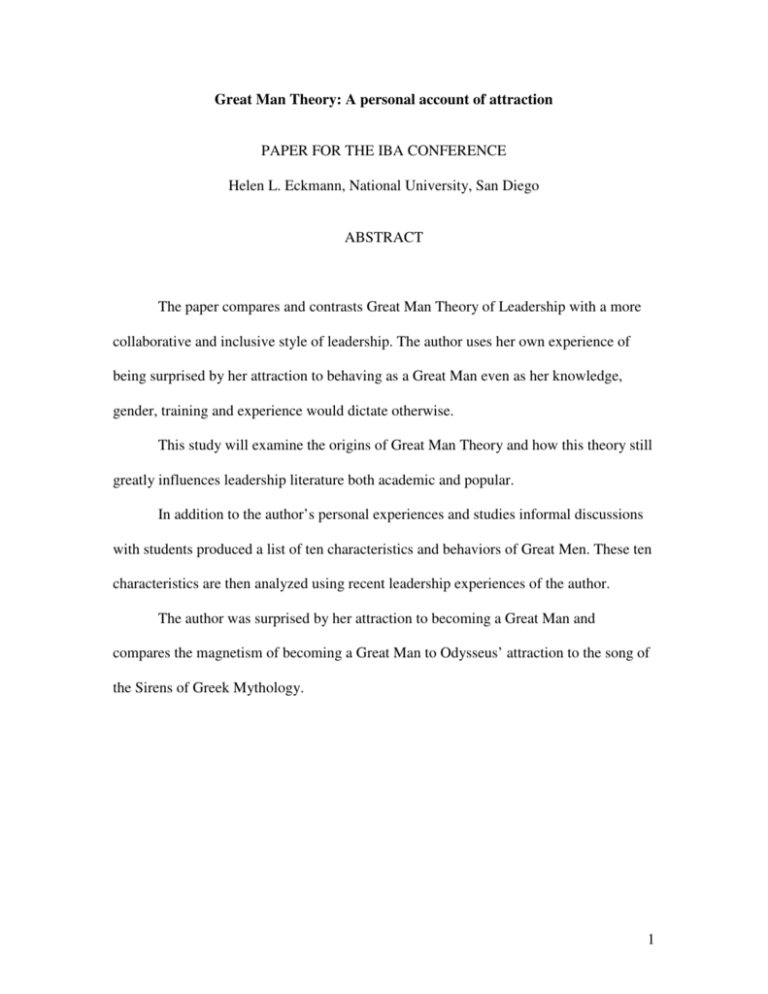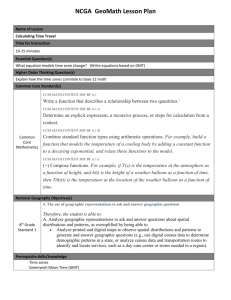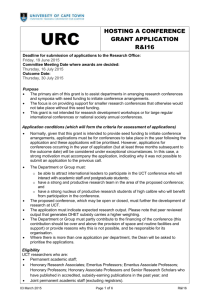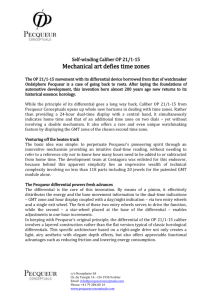Great Man Theory: A personal account of attraction
advertisement

Great Man Theory: A personal account of attraction PAPER FOR THE IBA CONFERENCE Helen L. Eckmann, National University, San Diego ABSTRACT The paper compares and contrasts Great Man Theory of Leadership with a more collaborative and inclusive style of leadership. The author uses her own experience of being surprised by her attraction to behaving as a Great Man even as her knowledge, gender, training and experience would dictate otherwise. This study will examine the origins of Great Man Theory and how this theory still greatly influences leadership literature both academic and popular. In addition to the author’s personal experiences and studies informal discussions with students produced a list of ten characteristics and behaviors of Great Men. These ten characteristics are then analyzed using recent leadership experiences of the author. The author was surprised by her attraction to becoming a Great Man and compares the magnetism of becoming a Great Man to Odysseus’ attraction to the song of the Sirens of Greek Mythology. 1 In Classical Greek Mythology Odysseus bound himself to the ship’s mast so that he would not be attracted to the song of the Sirens. The Sirens’ song persuaded passing mariners to crash on the rocks. The island they occupied was full of the bones of those who had perished (Vandiver, 2000). The study is based on the solid academic grounding using personal voice in research. Using a personal voice is a form of research and is often essential in studying experience. The tradition of inclusion of voice in research has emerged more fully as women have become researchers and the subjects of research (Abu-Lughod, 1993; Berkin & Horowitz, 1998; Lather, 1991; Lather & Smithies, 1997; Luria, 1968; Lerum, 2001; Wagner-Martin, 1994). Further, leadership literature often uses personal voice (Behar, 1996; DePree, 1992; Giuliani, 2002; McIntosh, 1985). Thus, the author will describe ways in which the author — a white woman — experienced an unexpected and unwanted attraction to trying to act like a Great Man. Great Man Theory (GMT) is the well-spring from which much of the leadership literature derives (Bass,1990; Bennis, 2003; Burns, 1978). The literature describes Great Men (Northouse, 2004).Like many others, I had worked for leaders who had started to lose their humility after read the literature on GMT and started to believe they were Great Men. As I studied the field of leadership my belief was that leadership that is exercised as a collaborative and inclusive activity could be most effective. When given chances to lead I 2 was confident I would do so in a highly collaborative and inclusive manner. I was later surprised to find myself displaying Great Man (GM) tendencies while exercising leadership. The purposes of this paper are to contrast the Great Man Theory of leadership with the more interactive theories of leadership, and to explore my unexpected attraction to act like a GM. Early studies of leadership often focused on those who were already great leaders, such as Gandhi, Churchill, Jesus and Mohammad. These are examples of great men influencing their times for good. Frequently, great leaders came from the aristocracy because the lower and middle class were rarely given opportunities to lead. This caused some early researchers to posit that breeding had something to do with leadership. Napoleon, who said he was born to lead, expressed his feelings about the importance of leadership in his quip that he would rather have an army of rabbits led by a lion than an army of lions led by a rabbit (Bass, 1990). Most of the leaders featured in the early studies were male and nearly all of the researchers were also male, thus creating a golden opportunity for an andocentric bias in the early leadership literature. Great Man Theory is considered by many to derive from Trait Theory (Northouse, 2004) where leaders are born and look, act, and lead by preset, often genetic, fundamentals. Mann (1959) examined more than 1,400 findings and the results were that intelligence, masculinity, adjustment, dominance, extroversion and conservatism were the traits of leaders (Northouse, 2004). Early research on leadership often emphasized that leaders inherited certain characteristics or traits (Bass, 1990). These traits were studied to determine if other people who had such characteristics would also become great leaders 3 (Stogdill, 1974). Maxwell (1998), in describing empowerment, asserts, “the people’s capacity to achieve is determined by their leader’s ability to empower” (126). The term Great Man Theory has been originally associated with the nineteenthcentury Scottish historian Thomas Carlyle, (1841) who declared, “The history of the world is but the biography of great men” (p. 127). Carlyle argued that heroes shape history through the vision of their intellect, the beauty of their art, the prowess of their leadership and, most important, their divine inspiration. Because GMT emerged from such early studies, it is understandable that some of the current literature on leadership has its roots in GMT. Popular books on leadership, the type found in airports, often have an underlying premise that all good things are accomplished by the undisputed brilliance of one man. In a recent popular book, Leadership (2002), Rudolph W. Giuliani highlighted his decisions and actions during the events of the attacks on the Twin Towers in New York City. The book describes collaborative and inclusive activity, and yet, in the first three pages of his book uses the word “I or me” fifteen times and “we or us” five. Giuliani’s Chapter 9 is entitled “Be Your Own Man”. Giuliani’s best seller is the first book listed on Amazon.com when one searches for a book on leadership.1 Autobiographies about how one man makes a difference have their origins in GMT. Similarly, a preponderance of the widely accepted academic leadership literature historically has described how great men do great things (Bass, 1990; Bennis, 2003; Burns, 1978; O’Toole, 1995; Marshall, 1991; Rost, 1991; Tichy, 1997). GMT highlights how one man (sometimes but not often a woman) is the primary impetus for successful leadership. Rost, (1991), Burns (1978), Covey, (1990) often have leader-centric (rather 1 As of the writing of this paper on March 5, 2005 4 than collaboration-centric) themes within their works. “Leaders as prophets, priests, chiefs, and kings served as symbols, representatives, and models for their people” (Bass, p. 3). As a woman who rarely if ever feels divinely inspired and certainly was not bred for leadership (neither of my parents are college graduates). I felt sorely lacking in the necessary traits (masculinity, dominance and conservatism to mention three) as described in the literature espousing GMT. Perhaps, even if Great Man Theory was named Great Man/Woman Theory I still might not have been drawn to leader-centric models of leadership. According to research, females are more likely to be drawn, by nature, to collaboration and inclusive leadership. One of the female pioneers in leadership literature was Carol Gilligan (1982). She challenged Kohlberg’s assumptions on stages of moral development as being malecentric. Gilligan researched Kohlberg’s methodological approach for his research. She noted Kohlberg had included over six different cultures and yet failed to include even one woman in his research. Gilligan posited that many of the standards for moral and leadership development had been drawn with the assumption that women experienced the same developmental process as men. Gilligan’s extensive research indicated that women develop differently then men. Her research on women’s development did not match with the Kohlberg findings. Women were inclined to be more inclusive and collaborative, while men tended to be more competitive. For girls and women, issues of femininity or feminine identity do not depend on the achievement of separation from the mother or on the progress of 5 individuation. Since masculinity is defined through separation while feminity is defined through attachment, male gender identity is threatened by intimacy while female gender identity is threatened by separation. Thus, males tend to have difficulty with relationship while females tend to have problems with individuation (Gilligan, p. 8). Thus, Gilligan’s findings demonstrated that women were more likely to lead with collaboration and inclusion, while men would lead using individuation, or would focus on one man (usually themselves). The GM’s of leadership lore were intelligent, swarthy, domineering, extroverted giants who were saviors of those unable to help themselves. As a woman, the underlying assumptions of GMT and Trait Theory had left me without support for personal leadership from the literature. However, Gilligan’s findings created a paradigm for leadership of inclusion which I felt was possible for me to model. Recent leadership literature offered a model with an invitation to both genders to participate in leadership a model that is more collaborative and based on inclusion. Predominantly, Heifetz (2002) differentiated the word “leader “from the word “leadership.” Heifetz thus separated leadership from the accomplishments of one great man. By means of the Heifetz model any one at any time can exercise leadership. Heifetz brought good news for me: Even if I was not bred to be a leader I could still exercise leadership. Heifetz argued that “Leader” may be a person, but “Leadership” is an activity, and anyone, from a four year-old girl to a middle-aged white woman, can exercise leadership. We have all experienced unlikely individuals who exercise leadership at the most unlikely of times. As an example, twenty years ago, Nancy 6 Brinker started the Susan B. Komen Foundation immediately after her 36 year-old sister died from breast cancer. Nancy, who had no previous experience in philanthropy, established an organization that currently has energized and included over 75,000 volunteers and has raised over $740 Million to find a cure for breast cancer. In 2002, President Bush named Nancy Brinker as the U.S. Ambassador to the Republic of Hungary. The website for the Susan B. Komen Foundation encourages inclusion “One person can make a difference.” (http://www.komen.org) As my knowledge of the contrast between GMT and of collaborative leadership grew, and as I completed my doctorate degree, I was given more frequent opportunities to exercise leadership in my work and community. Recently, I was given an opportunity to take a one-year leave from teaching to start a new department. After decades of professional experience working for and with those who thought of themselves as GM’s, I had vowed repeatedly that I would not lead as if the ones I was leading were blind. I was determined to set up an egalitarian organization that used collaboration and inclusion. I was determined that I would not exercise the qualities of a GM. Within a few months I discovered that I was not immune to the desire to become the Rudolph Giuliani of my small work world. I found myself strongly attracted to demonstrating behaviors that were often very much like those of a GM. I wanted to lead with collaboration and inclusion. I had a desire to compare and contract the differences in behaviors between collaboration and GMT. I analyzed the experiences I had working for GM’s. I desired to identify the ten main and plain categories of the behaviors of a GMT. 7 To conduct this analysis I began an informal study concerning GMT behaviors. As I was teaching leadership, ethics and management courses, I heard stories from students of their experiences of working with GM’s. I asked the students to describe the categories of behaviors that distinguished the people they had worked for who appeared to subscribe to the GMT. The following is a list compiled from these informal and formal discussions with students as well as my personal experiences. After describing the ways of the GM, I will describe ways in which I was surprised my behavior fell into many of these categories. “Great Men”: 1. Take more than their share of the credit 2. Act like the smartest persons in the room 3. Act like they care about others 4. Compete with everyone 5. Spend as much time as possible next to the big boss 6. Remind others of their expertise 7. Blame those below them 8. When things go wrong and they are unable to blame those below themselves, they start to micromanage in earnest 1. 9. Lose their ability to talk about anything but work 10. Seek to Be Their Own Man Take all of the credit As I began the new department on my one year leave from teaching I was determined to established frameworks for sharing the credit, inclusion and collaboration. 8 The new department had seven major priorities, one of which was to develop a brochure. Two of the team members had worked hundreds of hours on the brochure. I started the ball rolling on the project, but shortly thereafter I focused on other priorities. A few months after the brochure was completed the Chief Financial Officer came into my office to congratulate ME on the brochure. I could feel a strong internal pull to say “thank-you” and take all of the credit. I knew on some level that I wanted to take all of the (undeserved) credit. This was a clue that I was heading into GM territory. After the CFO left my office I realized that a classic “devil on the left shoulder” and “angel on the right shoulder” struggle had ensued and I had barely survived. I may have been struggling with pride at this moment and pride may be a source for GMT behavior. 2. Act like I am the smartest person in the room I started in new and highly inappropriate ways the annoying habit of interrupting people. In the past this had not been a tendency of mine but I found that I was having trouble letting ANYONE finish their sentences. In one very important meeting a marketing question was addressed to one of my coworkers (one of the two who had “built” the brochure). The woman is an Introvert and took more than two seconds to start to respond and I jumped in and took over the next several minutes of the meeting. 3. Act like I care about others Before I took on the new department I often said hello, using their names, to the coworkers who deliver the interoffice mail and the receptionist (at one point I was a 9 receptionist). Soon after taking on the new responsibility I found that the names of these workers were not easily recalled. Eventually when I saw some coworkers approaching in the hall I would look down or pretend to read something. Other times I would quietly ask those around me what the name of the mail person was, but the next day I would have to ask again. In my opinion I was enjoying being with the aristocracy and was less concerned with the plight of the ranks from which I came. 4. Compete with everyone I was beginning to think of myself as Alice, Teddy Roosevelt’s eldest daughter, purportedly said about him: “He wants to be the bride at every wedding and the corpse at every funeral.” I went to meetings and wanted my new department to receive accolades. I found myself wanting to be on the top of every list. I found myself as jealous and petty as I remembered junior high school. 5. Spend as much time as possible next to the big boss. At each department meeting I started arriving earlier and earlier to be sure that I did not have to sit at the “other” end of the room. I found myself wearing bright colors at meetings and sitting up very straight with a gold pen and a clean sheet of paper my eyes focused on the door until the boss arrived. 6. Remind others of my expertise 10 A few years before starting this department I had five years’ experience working in a related field though in a different capacity. I found that I wanted to talk about that experience more than appropriate. I found that I had the desire to insure others around me knew, without a doubt, that I was qualified to run the new department. I was talking more about myself (particularly in a flattering light) than I had remembered doing in the past. At one point I noticed I was telling a flattering story about myself while others were looking at their feet. In many of the courses I had asked students to learn if they were a high selfmonitor or a low-self monitor. The Internet test to determine this is The Interaction Model. When I took the test my score was 22 out of a possible 25 points. This meant that I was normally a high self monitor “High self-monitors are more active in conversations and tend to talk about the other person instead of talking about themselves” (Snyder, 1974). (http://pubpages.unh.edu/~ckb/SELFMON2.html) During my time living in GMT land I became a low-self monitor “Low selfmonitors rely on their own inner attitudes and emotions rather than social cues from others to guide their behaviors.” (Snyder, 1974) 7. Blame those below me in the organizational chart This particular trait of the GM I was able to avoid. I did not find it attractive. I had the privilege of putting together an amazing team and the thought of blaming them for anything was inconceivable. In the past when I had previously worked for a GM’s I remembered how it felt when the blame would flow down the organizational chart. I remember once, when working in a very low-level administrative position with little 11 responsibility and no authority, being blamed for a project’s lateness. When working for a GM in the lower ranks of an organization I remembered blame was like rain in Seattle – constant and inevitable. 8. When things go wrong and I can’t blame those below me, start to micro- manage in earnest. Remembering this one is most painful. When the revenues of the new department began to lag projections I started to involve myself in everything, down to the slightest detail. I wanted to be in on every decision and meeting, where just a few months before I was willing to delegate something as important and vital as the brochure. I was now all ears when ANY telephone rang. Teddy Roosevelt said, “The best executive is the one who has sense enough to pick good men to do what he wants done, and self-restraint enough to keep from meddling with them while they do it.” I lost that in GMT land. When I felt the goals were not being met I did not blame others, but I did not trust them either. I meddled and this was confusing and disheartening to those who had worked so hard. 9. I lost the ability to talk about anything but work This is where I started to most resemble a GM. My family grew tired of my seemingly endless recounting of daily victories (especially the victories) and defeats. No detail was too small, no event too insignificant to unload on my family. I recall going into detail with my family over an event at work. The telling of the event took fifteen minutes though the actual event took only a few minutes. The problem was not only that I talked 12 about work all of the time, the difficulty was also that I thought about work constantly. At one point my daughter-in-law called me at work with a serious health concern and I found myself staring at my calendar thinking of how I could fit her into my schedule. 10. Be My Own Man I found myself when meeting new people to have a hard time waiting for them to introduce themselves so I could tell them all about my new job, title and big office. Closing It is painful to recall these details of my journey of becoming a GM. I knew better. I have enjoyed my experiences working within organizations that are collaborative and inclusive. Our department was more effective during the times that I was able to exercise the behaviors more closely associated with collaboration and inclusiveness. What I found is that being a GM did not make me great at all. I was just another, selfish, priggish, department head who was less able to monitor and control my pride in social situations. I was not monitoring my behavior. I have returned to my first love, teaching, and I am further away from the Sirens of pride. Perhaps most important, I now have a personal experience to add to the popular and academic literature on leadership. There is an unexpected and unwanted attraction to attempt to become a leader-centric Great Man (even as a woman). Perhaps, with knowledge gained, I will be less critical of those who behave as a GM, and will remember that even women who know better can be distracted by the Sirens Song of pride. 13 Odysseus bound himself to the ship’s mast so that he would not be distracted by the song of the Sirens in Greek Mythology. I was surprised by the magnetism to become a Great Man. 14 References: Abu-Lughod, L. (1993). Writing women’s worlds – Bedouin stories. Berkeley, CA: University of California Press. Bass, B. (1990). Handbook of leadership. New York: Macmillian, Inc. Behar, R. (1996). The vulnerable observer: Anthropology that breaks your heart. Boston: Beacon Press. Bennis, W. (2003). On becoming a leader. Cambridge, MA: Perseus Books Group. Berkin, C. & Horowitz, L. (Eds.). (1998). Women’s voices – women’s lives. Boston, MA: Northeastern University Press. Burns, J. (1978). Leadership. New York: Harper & Row Publishers, Inc. Burns, J. (2003). Transforming leadership. New York: Atlantic Monthly Press. Carlyle, T. (1841). On heros, hero worship and the heroic in history. Boston: Adams. Covey, S. (1990). Seven habits of highly successful people. NY: Fireside. DePree, M. (1992). Leadership jazz. New York: Dell Gardner, J. (1990). On leadership. New York: The Free Press. Gilligan, C. (1982). In a different voice. Boston: Harvard University. Giuliani, R. (2002). Leadership. New York: Hyperion. Heifetz, R. (1994). Leadership without easy answers. Cambridge, MA: Harvard University Press. Heifetz, R. & Linsky, M. (2002). Leadership on the line. Cambridge, MA: Harvard University Press. Komen, Susan B. Foundation http://www.komen.org 15 Lather, P. (1991). Getting smart: Feminist research and pedagogy within the postmodern. New York: Routledge. Lather, P. & Smithies, C. (1997). Troubling the angles: Women living with HIV/AIDS. Boulder, CO. Westview Press. Lerum, K. (2001). Subjects of desire: Academic armor, intimate ethnography, and the production of critical knowledge. Qualitative Inquiry, 7, 466-483. McIntosh, P. (1985). Feeling like a fraud. Wellesley, MA: Wellesley College Press. Mann, R. (1959). In Northouse, P. (2004, 3 Eds. 17). Leadership theory and practice. Thousand Oaks, CA: Sage Publishing. (17). Maxwell, J. (1998). The 21 irrefutable laws of leadership: Follow them and people will follow you. Nashville: TN. Thomas Nelson Publishers Northouse, P. (2004). Leadership theory and practice (3 Eds.) Thousand Oaks, CA: Sage Publishing. O’Toole, J. (1995). Leading change. San Francisco: Jossey-Bass Publishers. Rost, J. (1993). Leadership for the twenty-first century. Westport, CT: Praeger Publishing. Snyder, Mark. (1974) Self-Monitoring Scale http://pubpages.unh.edu/~ckb/SELFMON2.html Stogdill, R.M. (1974). Handbook of leadership: A survey of the literature, New York: Free Press. The New Dictionary of Cultural Literacy, Third Edition. Edited by E.D. Hirsch, Jr., Joseph F. Kett, and James Trefil. Copyright © 2002 by Houghton Mifflin Company. Published by Houghton Mifflin Company. 16 Tichy, N. (1997). The leadership engine. New York: HarperCollins Publishers, Inc. Vandiver, E. (2000). Classical Mythology. Chantilly, VA: The Teaching Company. Wagner-Martin, L. (1994). Telling women’s lives: The new biography. New Brunswick, NJ: Rutgers University Press. 17 18








